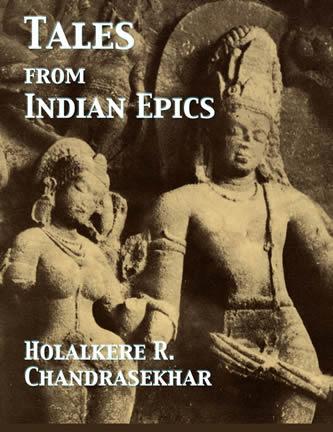Contribute
| Book Review - Tales From Indian Epics |
Nirmala Garimella
03/22/2004
Tales from Indian Epics
By Holalkere R. Chandrasekhar
306 Pages
Available in the US
In the very first story in the ‘Tales from Indian Epics’, ‘Brahma urges Valmiki to write the poem of the Ramayana thus “Thousands of years hence, this story will be told and retold. Many authors will interpret it in plays and ballads. Children will act out skits in languages yet to be born. People of alien races and cultures, clad in strange costumes, speaking stranger tongues, and living in lands far away from here will listen to this tale and admire it”.
Taking a cue from this story Holalkere ChandraSekhar, the author of this book seems to have done just that. He has rewritten some of these timeless classics in a clear, engaging and entertaining manner. The book is an affirmation that one can hold on to the authenticity
of the original epics and at the same time express ideas suited to the world around us.
The selected stories reflect the theory that meaningful stories are those that cannot be static; our
selections and interpretations of stories change from age to age. On this aspect, the author comments “Most of the stories can be found in Ramayana, Mahabharatha and Bhagawatha, which are the quintessential works of ancient India. The stories are slightly different in detail and emphasis in these books. I have synthesized different versions in some stories. In others I have modified them”.
In the foreword to the book, for instance he writes “Ancient cultures, being predominantly patriarchal, depict women in subordinate roles. Inn order to be respected, women are expected to be virtuous and submissive. While preserving the spirit of the old narrators for the sake of historical accuracy, he admits that he has “adapted the characters to reflect the sensibilities of the modern reader “. Chandrasekhar’s depiction of the Rama and Sita story is one example. He says”“It substantially differs from popular versions (Valmiki, Tulsidas and Kamban) but I believe that is the way it actually happened” Moving away from the original narration, he depicts the woman to be strong, independent and free spirited. In Shakuntala , for example when Dushyant fails to recognize her because of the loss of the ring, she walks away from him spiritedly saying she would not bear another word of insult. Similarly Devayani, Urvashi and Savitri act with courage and wit in their circumstances.
When Chandrasekhar wrote this book he says “ I had my children in mind when I thought of writing the book. I have had very good response from children as young as 9 and people as old as 70. I wanted to give a modern perspective to these ancient tales without compromising their integrity. Young people are curious about our ancient epics but have the difficulty of language (originals are in Sanskrit and the translations are voluminous and often hard to read.) I wanted to bring the characters and incidents alive in these tales so that they are relevant to us now.
On the response to this book he comments “I am grateful that the response has been so good. I have had a number of emails and I have compiled them into a word file. One person wrote that his mother, who is seventy, sat up all night and read the book from cover to cover. I can understand that. Most of us grew up in India listening to these tales. We are nostalgic about them. That explains the response of older people. The book has brought in responses from several Indian cultural groups according to the author who have bought books in bulk and distributed to their kids. Several others have come back to buy it for their friends and family”.
‘Tales from Indian Epics’ has a total of 29 tales in all and includes classics such as Shakuntala, Damayanti, Savitri, Bhagirath, Harischadra,Urvashi, and Devayani. It also includes rare stories such as Astika, Jadabharata and Madalasa, abridged versions of the Ramayana and the Mahabharata and stories from the Bhagawat Purana. The illustrations are by Pramila Vishwanth.
http://www.amazon.com
Contact the author:
Email: chandra@missouri.edu
You may also access this article through our web-site http://www.lokvani.com/
